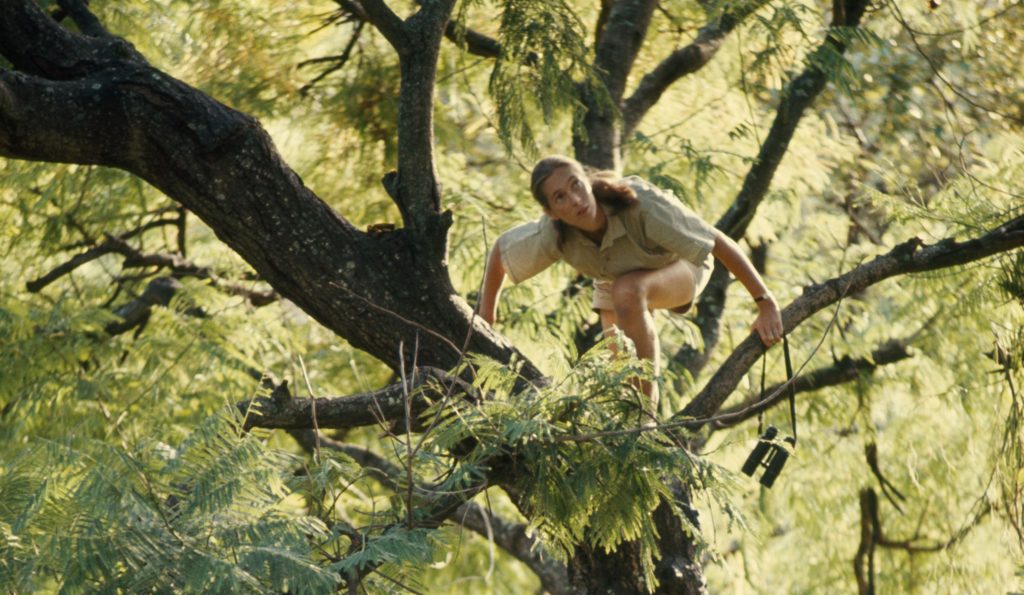National Geographic’s ‘Becoming Jane’
By • March 2, 2020 0 2695

Jane Goodall is 85. When she showed up at Tanganyika’s Gombe Stream Game Reserve in the summer of 1960 — with her mother as chaperone and a cook named Dominic — she was 26.
As many of us learned as animal-loving youngsters, Goodall had gone to Tanganyika (now Tanzania) to observe chimpanzees in the wild. What came to be a 60-year calling began with a suggestion from paleoanthropologist Louis Leakey, who, with his colleague and wife Mary, was finding and studying fossils of human ancestors. Goodall had sought out Leakey, the son of missionaries in British East Africa, three years earlier.
“Becoming Jane,” an immersive exhibition about Goodall’s remarkable life and career — created in partnership with the Jane Goodall Institute, a conservation organization based in Vienna, Virginia — opened last November at the National Geographic Museum. It will remain on view through the summer, then travel to the Natural History Museum of Los Angeles County and other venues.
In addition, the famed primatologist, since 2004 a Dame Commander of the Most Excellent Order of the British Empire, will be celebrated in D.C. this spring with a series of public events.
On March 13, filmmaker Bill Wallauer, the Jane Goodall Institute’s scientific advisor, will lead a virtual-reality journey through the forests of Gombe (National Geographic boasts the world’s largest VR theater).
This year’s Environmental Film Festival in the Nation’s Capital will conclude on March 21 with a world-premiere screening of “Jane Goodall: The Hope.” And on March 23, Sara Manco and Karen Cerka, National Geographic’s photo archivist and film archivist, will conduct a Goodall-themed “Into the Archive” program.
The March events will all take place at National Geographic headquarters, as will a one-day Jane Goodall Film Festival, running from 11 a.m. to 8:30 p.m. on May 9.
Goodall herself will make an appearance on April 6, three days after her 86th birthday, at DAR Constitution Hall.
“We’ve been telling her story since 1960,” noted Kathryn Keane, executive director of the National Geographic Museum and vice president of public experiences at the National Geographic Society.
Keane called Goodall “gracious” during the planning process for the exhibition — which required a lot of custom voiceover work — but “also very outspoken and firm about things that she wanted.”
Visitors to the exhibition get a taste of multimedia right at the start, when blowups of three National Geographic Magazine covers switch to video. The star of the show greets them (“Hello, I’m Jane Goodall”), then a chimp escapes from the famed yellow frames.
“Becoming Jane” offers “a lot of things to see and do and play with,” said Shawn Sweeney, the Jane Goodall Institute’s senior director of community engagement. That’s an understatement. At “Chimp Chat” booths, for example, one can practice speaking chimp. At an “Observation Station,” augmented-reality characters appear in binoculars, accompanied by a narration.
But this visually appealing show strikes a balance between stations that make use of interactive and immersive technologies and traditional displays of one-of-a-kind artifacts. To name two of the latter: Jubilee, Goodall’s stuffed chimp from childhood, named for the baby born in 1935 (the year of George V’s jubilee) to Boo Boo, a chimp at the London Zoo; and a four-page letter home written by the 22-year-old Goodall while on a three-week ocean voyage to Mombasa on the Kenya Castle.
A bit farther along, visitors are welcomed to Chimpland — Goodall’s name for her Gombe camp — by a hologram of the young researcher. Later, theater doors open and one dons glasses for a stunning 360-degree experience, during which Goodall describes the moment when chimps she named Goliath and David Greybeard preened near her for the first time, unafraid: “Without any doubt, this was my proudest moment.”
Goodall enrolled at the University of Cambridge from 1962 to 1965, earning a Ph.D. in ethology, the study of animal behavior. The paradigm-changing, fiercely challenged observation in her thesis, “Behaviour of Free-Living Chimpanzees,” was of chimps making and using tools. Man (that is, humans) could no longer be uniquely characterized as “the Toolmaker.”
Early film footage of Goodall interacting with chimps — a practice that is no longer sanctioned — was shot by Hugo van Lawick, a photographer and filmmaker born in Indonesia to Dutch parents. Also directed to Gombe by Leakey, van Lawick married Goodall in 1964 and they had a son, Hugo Eric Louis, known as Grub, three years later (the couple divorced in 1974 and van Lawick died in 2002). Goodall has two grandsons, Merlin and Nick, and a granddaughter, Angel.
What is referred to as Goodall’s “Damascus Moment” came in 1986, when she published “The Chimpanzees of Gombe: Patterns of Behaviour” and spoke at a conference in Chicago. Just as she then adopted a more holistic approach, focusing on the protection of animals through environmental conservation and sustainable human practices, the exhibition shifts in midstream to a wider lens.
Four threats — habitat loss, disease, trafficking and hunting — are flagged, and ways to combat them identified. Background is provided on the Jane Goodall Institute’s Roots & Shoots program, which works to motivate youth throughout the U.S. and in some 50 countries, and its community-centered Tacare approach.
Finally, at Trees of Hope kiosks, visitors pledge to make a change in their routines: Use Less Plastic, Avoid Palm Oil, Take A Walk.
Compared with Goodall’s lifetime of devotion, it seems a small thing to ask.
Becoming Jane
National Geographic Museum, 1145 17th St. NW
Open daily, 10 a.m. to 6 p.m.
Admission: $15

